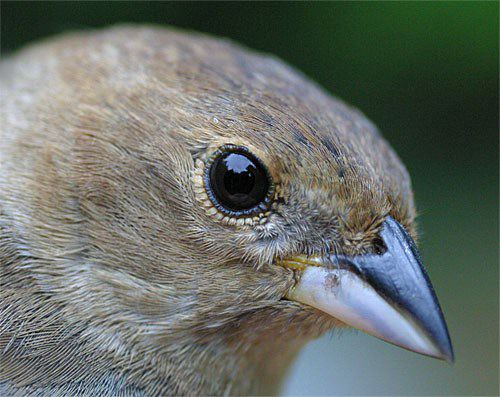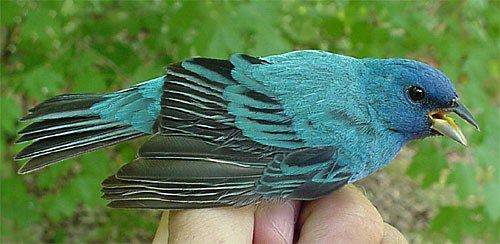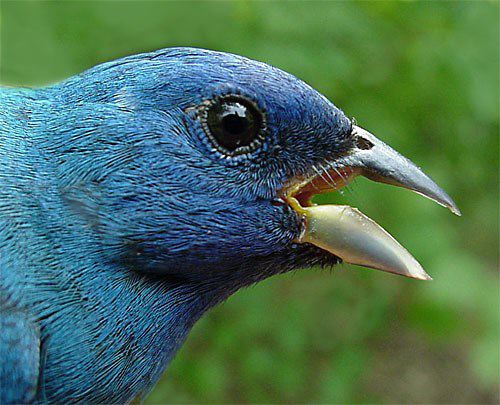|
|
|||
|
|
|||
(Back to Preceding Week; on to Next Week)
|
A MOST NONDESCRIPT BIRD When beginning birdwatchers seem overwhelmed at trying to identify all the avian visitors to their backyards, we first remind them that everybody--novices and experts alike--learns new species the same way: one bird at a time. Then we suggest the use of three criteria that help in identification of any new bird: color, size, and shape. Of these, the one most folks notice most quickly is color, including field marks such as spots, wing bars, eye rings, and tail spots. We tell beginners that with a little work and a trusty field guide, even a sparrow, female duck, or winter shorebird can USUALLY be identified, but just when novices start to feel a little confident with their skills, the "most nondescript bird in North America" suddenly shows up at a feeder in spring and confounds them completely. That's when we get phone calls that start out with "I've got this little brown bird eating sunfl . . . ." Most of the time they don't even have to finish the sentence before we suggest "female Indigo Bunting." 
All text & photos © Hilton Pond Center Indeed, female Indigo Buntings (above and below left) at first glance are totally devoid of field marks and have no distinctive shape or size. Their bodies are covered by neutral brown feathers, and wings and tail are colored to match. There's no eye ring and only a hint of wing bars, but a close examination of the bird's head finally provides a hint for identification: a two-tone bill in which the top is black, the bottom pinkish-tan. Male Indigo Buntings are vastly different from their mates. The male is one of the most brilliant birds in North America and sports shades that are downright breathtaking--indigo being just one of the colors that adorns this nearly all-blue bird. (The species' scientific epithet, Passerina cyanea, refers to "cyan" blue.) In the adult male (below and bottom photo), the head--which bears the same two-tone bill as the female--is usually a darker, richer blue that blends into a slightly more greenish hue on the back and belly; the wings and tail are black but edged with the same blue as the body. We've tried many times to put into words the various colors on an Indigo Bunting but simply have to settle with saying they're "indescribable." 
Some folks think the boldly blue Indigo Bunting is a show-off, since the male establishes his territory by singing loudly and continuously from a highly visible perch atop the tallest tree he can find, beneath which is invariably a shrub layer in which the female can build a tightly woven nest that may be only a foot or so off the ground. The male's unmistakable song consists of four sets of couplets repeated in rapid succession, which to our ear can be symbolized by . . . The words in larger type denote a higher pitch. Parents and offspring also communicate with a ventriloquistic tsick call that doesn't betray their locations to a potential predator. Newly fledged Indigo Bunting males look like females, with the addition of very faint streaking on the breast. By the time they return to North America as second-year birds next spring, most males will have developed a calico appearance, with varying degrees of brown, blue, and even grayish feathers scattered through their plumage (below right). Markings on these younger males are as distinct as fingerprints in humans, and various individuals can be differentiated at the feeder. Indigo Buntings are Neotropical migrants; they spend the breeding season in the eastern and central U.S. and Canada and then fly to the West Indies, Mexico, and as far as Panama for our winter months, with a few stragglers hanging back in south Florida and the Gulf Coast of Texas. South of the border the Indigo Bunting meets up with two congeners; the Lazuli Bunting, P. amoena, a western counterpart with which it occasionally interbreeds where the species' ranges overlap; and the Painted Bunting, P. ciris, which breeds primarily along the Carolinas coast and in the south central and southwestern United States. Chan Robbins, one of the world's most prolific bird banders, was so enamored of these three bunting species that he put them on the cover of his Golden Press field guide to Birds of North America. Like many other Neotropical migrants, buntings are subject to habitat destruction in Mexico and Central America, but because they tend to hang out along edges and in shrubby areas they may be less at risk than birds that rely upon dense stands of tropical rain forest to make it through the winter. On this end of their range, Indigo Buntings in particular seem adapted to nesting along power line rights-of-way, and there are certainly plenty of those to go around! Unfortunately, many individuals are lost each year during migration when they fly into buildings and TV towers at night, and on the breeding grounds an entire brood may perish because Indigo Bunting nests are frequent hosts to Brown-headed Cowbird chicks.  From April through October, we see Indigo Buntings fairly frequently at Hilton Pond Center; this week's capture is the 310th since 1982, making it the 25th most common of our 123 species banded. Some spring and fall birds undoubtedly are migrants, but the presence of recent fledglings in summer indicates some Indigo Buntings are breeding locally and perhaps on-site. Apparently the brightly colored and highly vocal males are doing a good job establishing food-rich territories, while the females are able to hide the eggs and chicks long enough to bring off another generation of Indigo Buntings--thanks, of course, to those females being VERY nondescript. Comments or questions about this week's installment?
Thanks to the following fine folks for recent gifts in support of Hilton Pond Center for Piedmont Natural History and/or Operation RubyThroat: The Hummingbird Project. Your tax-deductible contributions allow us to continue writing, photographing, and sharing "This Week at Hilton Pond." (Please see Support if you'd like to make a gift of your own.)
"This Week at Hilton Pond" is written & photographed You may wish to consult our Index of all nature topics covered since February 2000. You can also use our on-line Hilton Pond Search Engine at the bottom of this page. For a free, non-fattening, on-line subscription to |
|
SPECIES BANDED THIS WEEK * = New species for 2003 WEEKLY BANDING TOTAL 6 species 9 individuals
YEARLY BANDING TOTAL (2003) 43 species 545 individuals
BANDING GRAND TOTAL (since 28 June 1982) 123 species 42,659 individuals
NOTABLE RECAPTURES THIS WEEK (with original banding date, sex, and current age) Northern Cardinal (2) Downy Woodpecker (1) Tufted Titmouse (1) Eastern Towhee (1) |
(adult male) This species has been in decline at Hilton Pond Center, due perhaps to destruction of its winter habitat in the Neotropics. Natural succession at the Center also may have had an effect, since most shrubby areas that are favored by yellowthroats have been replaced by mixed woodland over the past 20 years. OTHER SIGHTINGS OF INTEREST --A first-year Red-shouldered Hawk that likely was locally produced has been hanging around Hilton Pond Center in recent weeks, has been preying on Cotton Rats, Eastern Chipmunks, and--as observed on 20 May--a Brown Thrasher. --After five years of drought at the Center, it seems like every week in the spring of 2003 has brought rain--usually on days when we'd rather be running mist nets. This week we got another 2" of precipitation but only nine new birds banded. |
|
|
|
(Back to Preceding Week; on to Next Week) Up to Top of Page Back to This Week at Hilton Pond Center Current Weather Conditions at Hilton Pond Center |
 You can also post questions for The Piedmont Naturalist |
Join the |
Search Engine for |
|
|